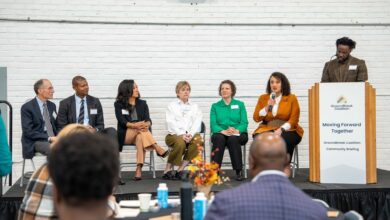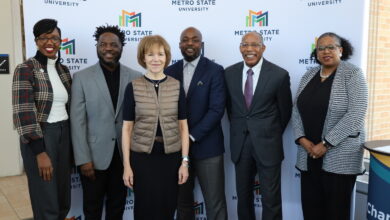Revitalizing a historical Black presence: the 38th Street Corridor


Conclusion of a three-part story
This story concludes our look at the 38th Street Corridor, one of the ‘cultural districts’ city leaders hope can help restore what was lost in the destruction following the police murder of George Floyd.
Sam Willis Jr. is a co-owner of Just Turkey, a restaurant near 38th and Chicago, with his business partner Cedric Steele. He shared his frustration at the financial support that’s been offered to him and other business owners since the street closures at the start of the 2020 civil unrest.
“We weren’t able to get the things that our tax dollars paid for,” he said referring to the lack of police and emergency service vehicles coming through the square due to blockades enforced by local activists. “By them barricading the area, it put an economic strain on our businesses.”
As a Southside native, Willis had always wanted to open up a business in his neighborhood. When he finally got the chance to see that dream come to fruition, the pandemic had shattered his hopes. Just Turkey was set to open in the spring of 2020, but state inspectors were unable to certify the business because of the COVID-19 pandemic, according to Willis.
– ADVERTISEMENT –
Once regulations began to ease, former Minneapolis officer Derek Chauvin murdered George Floyd just yards away from his business, causing a global outcry for justice. The civil unrest that followed Floyd’s murder further delayed the opening until October of 2020.
George Floyd Square neglected
Councilmember Jenkins led a virtual summit on the 38th St. Cultural District this past October to highlight the programs and resources available to local businesses and property owners. Some of the programs provided free resources such as business technical assistance and facade improvement matching grants, but also forgivable and small interest loans.
The summit also highlighted financial support from the Comcast Rise Grant, which recently awarded 100 businesses with $10,000 grants. Among the recipients listed are businesses located around the Twin Cities metro area in counties such as Anoka, Dakota, Carver and Hennepin.
The grant’s title stands for Representation, Investment, Strength and Empowerment. It aims to provide businesses with technological makeovers and marketing services.
– ADVERTISEMENT –
“While we know that no single organization can solve historic and systemic inequities overnight, we are committed to taking tangible actions that can drive long-term impact and change,” said Kalyn Hove, regional senior vice president of Comcast Twin Cities. “Comcast RISE and the Comcast RISE Investment Fund offer the opportunity for small businesses owned by people of color to help grow their businesses, create jobs, and play a vital role in supporting our communities.”

The George Floyd Community Benevolence Fund was also mentioned as a resource and is awarding grants of up to $25,000 for business owners to take part in. Many nonprofit organizations have been tasked with allocating millions of dollars to communities of color whose neighborhoods have been impacted by the civil unrest.
Alicia D. Smith is the executive director of the Corcoran Neighborhood Organization and a member-elect of the Minneapolis Parks and Recreation Board At-large. She has been an advocate for the businesses in the square and shares Willis’ frustration at the lack of direct support to those in the immediate vicinity of where Floyd was killed.
“What I know is that the business owners over in the square have been left out of the conversation,” she said. “Even when you talk about the recovery in Minneapolis, there is literally no mention of 38th and Chicago, which is asinine.”
The City provided business owners and nonprofits in the square with $50,000 interest-free, forgivable loans as an effort to address their unique challenges on the condition that their business or organization stayed open for another year. Willis measured this support as “pennies on the dollar” compared to what he and others in the square need.
– ADVERTISEMENT –
Smith highlighted that these businesses had lost hundreds of thousands of dollars and this loan was just a drop in the bucket. “That’s maybe what they pick up in cutlery supplies or to-go containers,” she explained. “It was a nice gesture, but it also needs to continue to flow to help those businesses stay on track to keep their doors open.”
Carmen Means, executive director of the Central and Bryant Neighborhood Organizations and a board member of Sabathani Community Center, shared Smith’s frustration with the lack of support for business owners on 38th. “We have not seen the same resources, even the same conversation, even the same guidance as around Lake Street,” she said.
“We are unfortunately as Black folks always in the middle of what we consider the oppression Olympics.” Means and Smith created the 38th St. Collective, which was an effort to drive support for businesses and community centers impacted by the civil unrest.
Although Means supported the calls for justice through protests and demonstrations, she emphasized that there should be a desire for economic change like there has been for judicial change. “If there is not an economic uprising, we still lose,” she said.
Means frames this economic justice in the creation of economic hubs, business centers in which Minneapolis’s Black communities can share resources and become self-sustaining. She calls for a business center specific to the Black community like Hmong Village, Karmel Mall, and Mercado Central. “They all have their own place to call home as far as business is concerned. Where is the space for Black people?”
– ADVERTISEMENT –
Taylor echoed Means’s point about developing a business center for Black people to congregate and leverage culture as an asset. “These communities move in and use culture as an asset to build an economically vital community,” he said. “That is the same thing Black people did in the ‘40s, ‘50s and ‘60s in the Northern states.”
Building consensus
The first efforts to revitalize this corridor date back to 2015 as former Ward 8 Council Member Elizabeth Glidden hosted a series of events titled “The Future of East 38th Street.” She focused on the efforts to identify development opportunities along the corridor and bring the district’s historically Black roots to the forefront.
The ward’s current representative, Andrea Jenkins, was involved in that work as Glidden’s policy aide and reignited that initiative in 2019 by creating THRIVE, a strategic development plan by the community in collaboration with the City.
It was an obvious decision for Jenkins to incorporate the 38th St. Corridor as a cultural district due to its historical significance to Minneapolis’ Black community. “I think the main thing about cultural districts is, you don’t create them,” Jenkins, city council vice president, said. “They sort of organically create themselves.”
The next stage is set to take place in early 2022 and is focused on engaging the residents, business owners, and community stakeholders along the corridor in reaching a consensus as to what they’d like to see in the district. Jenkins said that she’s in discussion with Lisa Tabor of Culture Brokers to help the City with their efforts to engage residents and business owners around their cultural district planning.
Having some familiarity with the framework and THRIVE’s short-term goals, Tabor said that a plan this complex needs to be broken down into smaller steps. “I think it’s probably safe to say that because that plan is so complex, there are so many different strategic improvement areas in that plan, that I think the strategy will likely be teasing those things apart and addressing each one of those focus areas,” she said.
Tabor suggested that it’s also important to step back and identify the parts that intersect and influence one another to know how well it’s coming together. She has worked with neighborhood development organizations like Aurora St. Anthony Neighborhood Council and cultural groups like the Asian Economic Development Organization, who she helped form the Little Mekong Business and Cultural District.
“Minneapolis is a different animal from Saint Paul in the respect of the cultural districts,” she explained. “In Minneapolis, they’re really kind of coming from the top-down, which is not a bad thing, but it just is a whole different circumstance that tries to get people to work together from the outside.”
Related stories:
Imagine a ‘resiliency hub’ for healing and health
Can Minneapolis restore its ‘cultural districts’?
Support Black local news
Help amplify Black voices by donating to the MSR. Your contribution enables critical coverage of issues affecting the community and empowers authentic storytelling.
























































